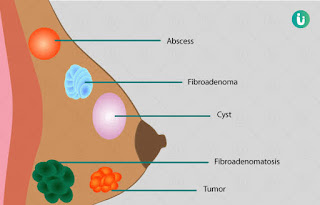Breast lump
Introduction
Brest Lump is a growth of tissue that develops within the breast. Breast lumps can have causes that aren't due to underlying disease. Examples include scars, fibroadenomas (benign fibrous growths), lipomas (benign fatty growths), cysts or overgrowth of ducts.
The lumps are milk ducts and tissues around them that have grown and widened to form cysts. These enlarge quickly in response to hormones released near your period. The lumps may be hard or rubbery and could feel like a single (large or small) lump. Fibrocystic changes can also cause breast tissue to thicken.
These changes are often most noticeable during your 40s. They’re the most common cause of benign breast lumps in women ages 35 to 50. Postmenopausal women are less likely to have these types of breast changes. That’s because they don’t have monthly changes in hormones.
Simple cysts: Simple cysts are fluid-filled sacs that usually affect both breasts. You could have one or many. They can vary in size. Their tenderness and size often change with your menstrual cycle.
Intraductal papillomas: These are small, wart-like growths in the lining of the mammary duct near the nipple. They usually affect women who are 30 to 50. They can cause bleeding from the nipple. Your doctor can remove them with surgery.
Traumatic fat necrosis: This happens when there is an injury to the breast, though you may not remember an injury happening. It causes fat to form in lumps that are generally round, firm, hard, and painless. You usually get one at a time.
It can be hard to tell if a lump from traumatic fat necrosis is that or something else until your doctor does a biopsy. These usually don’t need to be treated. But if the lump bothers you, the doctor can remove it.
Injuries and infections: A severe injury to your breast tissue or nearby nerves can create a breast lump. Doctors describe this condition as fat necrosis. A collection of infected fluid (abscess) in breast tissue also can cause a breast lump, one that's often associated with localized breast pain and inflammation of the skin.
Presentations
If you have an underlying breast condition, you might notice changes in how your breasts normally feel, such as:
- A round, smooth and firm breast lump
- A large, solid-feeling lump that moves easily under your skin
- A hard, irregular-shaped breast lump
- Skin redness or dimpling like an orange
- Changes in breast size or shape
- Fluid leaking from your nipple
Questions to ask when Diagnosing a lump patient
- When did you first notice the breast cyst or lump?
- Have you noticed a change in the size of the breast cyst or lump?
- What symptoms have you experienced, and how long have you had them?
- Do your symptoms occur in one or both breasts?
- Have any symptoms changed over time?
- Do you have breast pain? If so, how severe is it?
- Do you have nipple discharge? If so, does it occur in one or both breasts?
- How does your menstrual cycle affect the breast cyst or lump?
- When was your last mammogram?
- Do you have a family history of breast cysts or lumps?
- Have you previously had a breast cyst or lump, a breast biopsy or breast cancer
Lifestyle and Home remedies
To minimize discomfort associated with breast cysts, you might try these measures:
- Wear a supportive bra. Supporting your breasts with a bra that fits well may help relieve some discomfort.
- Apply a compress. Either a warm compress or an ice pack can help relieve pain.
- Avoid caffeine. Studies haven't shown a link between caffeine and breast cysts. However, some women find symptom relief after eliminating caffeine from their diets. Consider reducing or eliminating caffeine — in beverages, as well as in foods such as chocolate — to see if your symptoms improve.
- Consider trying over-the-counter pain medications if your doctor recommends them. Some types of breast pain may be eased by the use of acetaminophen (Tylenol, others) or nonsteroidal anti-inflammatory drugs, such as ibuprofen (Advil, Motrin IB, others) or naproxen sodium (Aleve, others).
Treatment
No treatment is necessary for simple breast cysts — those that are fluid filled and don't cause any symptoms — that are confirmed on breast ultrasound or after a fine-needle aspiration. Many cysts will disappear with no treatment. If a cyst persists, feels firmer or you notice skin changes on the skin over the cyst, follow up with your doctor.
Fine-needle aspiration
- Fine-needle aspiration may be used to diagnose and treat a breast cyst if all the fluid can be removed from the cyst during the procedure, and then your breast lump disappears and your symptoms resolve.
For some breast cysts, however, you may need to have fluid drained more than once. Recurrent or new cysts are common. If a breast cyst persists through two to three menstrual cycles and grows larger, see your doctor for further evaluation.
Hormone use
- Using birth control pills (oral contraceptives) to regulate your menstrual cycles may help reduce the recurrence of breast cysts. But because of possible significant side effects, birth control pills or other hormone therapy, such as tamoxifen, is usually recommended only for women with severe symptoms. Discontinuing hormone therapy after menopause may also help prevent breast cysts.
Surgery
- Surgery to remove a breast cyst is necessary only in unusual circumstances. Surgery may be considered if an uncomfortable breast cyst recurs month after month or if a breast cyst contains blood-tinged fluid or shows other worrisome signs.






Comments
Post a Comment
Was the article helpful? Say something